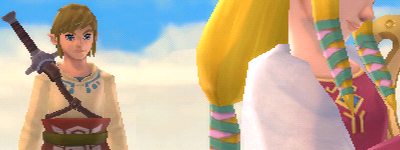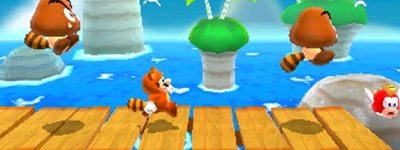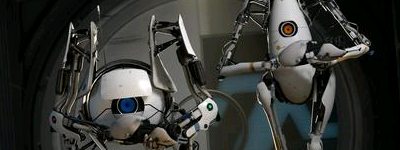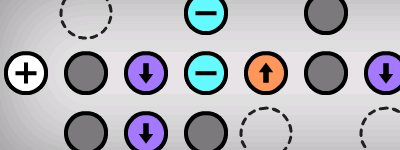Critical-GOTY 2011
 Saturday, February 25, 2012 at 9:34PM
Saturday, February 25, 2012 at 9:34PM Presenting my GOTY list is a tradition here at Critical-Gaming (2007 2008 2009 2010). The goal is " to present my GOTY mainly to reflect on my own personal tastes and hopes for design trends that I would like to see continued in 2012 and beyond." Unlike last year where I had already written full articles about most of the games on my list, this year the articles are in the works. This is most likely due to the fact that I played most of the games in the final months of 2011.

Radiant Historia
I've given RPGs a lot of flak over the years. But after blogging for the last 4 years and writing my article "Embrace the Abstraction" I see things more clearly than ever. Radiant Historia is a shining example of the type of high concept, high quality game design that's possible within the turn-based JRPG format. The battle system has depth held my interest throughout my entire experience. The story is intricate and layered due to the time travel structure that allows players to see many different results of their actions. It reminded me of the detail designed into Zelda Majora's Mask. The music is great too. By playing this game, I have learned a lot about about emergence and linearity, topics which I'll be writing about very soon. If you're still trying to gauge how much I enjoyed this game, consider this bold statement hanging out in the back of my mind: Radiant Historia is better than Chrono Trigger.

The Legend of Zelda: Skyward Sword
Every Zelda game is different. Every Zelda game seeks to innovate in different ways. Before I mention anything about Skyward Sword I wanted to explain why any discussion on Zelda is inherently difficult. Not only is the Zelda series loved for its story, characters, music, and gameplay. But Zelda gameplay is highly diverse covering exploration, puzzle, combat, and other genre. Just talking about the gameplay requires a firm grasp on game design concepts and language before you can understand how the various aspects of Zelda are balanced against each other. For these reasons I believe Zelda is the most difficult video game to discuss especially considering how many Zelda games there are that take advantage of nearly every Nintendo device and feature.
Having studied so many Zelda games in detail, I have a good understanding how how Zelda games are designed. I've noticed a trend in innovation of environment design that Phantom Hourglass and Spirit Tracks innovated in. So it's no surprised to me that Skyward Sword is designed around a concentrated set of areas with layered challenges. These locations are larger, more complex, and denser than the previous few Zeldas, and the DASH mechanic helps keep these spaces easily traversable. 3D environments are complex because the dynamic of 3D space is so powerful. Using the beetle, beacons, and visual vantage points, players have the tools to better learn these 3D spaces. To leverage this knowledge, various challenges were created in these environment very much like the Temple of the Ocean King in Phantom Hourglass (my favorite part of the game). I feel that this is a bigger innovation to how Zelda games are designed and how players play them than most will realize.
I love the music. I love the unfamiliar tale with its somewhat familiar elements. I love the new characters and the new world. There's so many wonderful design elements to talk about with Skyward Sword, though I know I have to replay it for myself to make sense of it all. If every game series was bold enough to make so many bold changes to the core gameplay in the same way that Skyward Sword completely embraces motion controls, we'd have a brighter 2012 to look forward to.

Super Mario 3D Land
Many games innovate. And most do it by refining features and elements that are fringe of the core gameplay experience. They take most of the established designed and add twists on top. For example, persistent leveling systems in multiplayer, co-op, achievements, and customisable elements. Super Mario 3D Land unwent some inward innovation on the very core gameplay dynamic that platforming games rely on; space. While Mario holds the title of best platformers in both the 2D and 3D genre, Super Mario 3D Land's design represents something different than 2D and 3D design.
The inherent limitations of movement directions and the overall lack of dynamic visual engagement is a wall 2D games cannot overcome. In other words you can only move up/down and left/right. Yet, while 3D games are free to explore a more dynamic space (X,Y, and Z) issues of controls, camera, cleanness, and ba3D enter the design. It seemed that after years of designing 3D games, few developers have successfully tackled these design issues of 3D gameplay.
3D Land not only merges the 2D and 3D level design conventions of past Mario games, but it also creates a perfect model of how games can be designed to take only the best of 2D and 3D level design. Like the Super Mario Galaxy games, the camera in 3D Land presents 2D side scrolling, 2D top-down, full 3D fixed camera, and 3D moving camera angles. Using the 3DS's stereoscopic technology, ba3D is almost entirely eliminated. Because the player has no effective control of the camera, the designers were able to tune the levels to best present the content to avoid emergent 3D clutter issues. The 8-way-analog movement mechanics of Mario is the perfect touch of simplified, quantified controls that gives players the snappy change in direction of a 2D Mario with the smooth analog control of a 3D Mario. And the levels are designed around these controls. You'll feel yourself almost snapping into the right directions though there is no aim assist.
Everything else about 3D Land is solid from the secrets, extras, to the music. It's a meaty game and a worthy challenge for a veteran like me. Mario is such a perfect game that I now dream of how this model can be applied to series like Metroid or Viewtiful Joe. And considering that Nintendo made Mario 3D Land in a relatively short development cycle the future of Nintendo looks good. No other game on my list innovated so much and executed at such a high level of polish in such a short period of time. This is why 3D Land gets my overall pick for game of the year.

Portal 2
I have reservations about sequels to puzzle games. You'll notice a certain lack of Layton on this year's GOTY list. Valve took their time developing Portal 2 and all of their hard work shows. Unfortunately, I feel that Portal 2 is an inferior puzzle gameplay experience than Portal. So much more emphasis was put on story and storytelling in ways that worked against the whole. All of the chatter and voice work is well written and funny as expected. But there was too much of it. Playing almost felt like I was in a comedy show where I was expected to just wait around and listen until the joke ended. Hearing the voice performances repeated after dying and respawning was annoying. And while there's a bigger mystery to uncover in Portal 2. But instead of uncovering it, it's just presented to you.
The non-test-chamber challenges were hit and miss. When they were a hit, I moved through them quickly and forgot about them. When they were a miss, I questioned whether my SD TV screen displayed the graphics well enough for me to notice the tiny, obscure spots that I had to use to progress. And I found bugs and other odd discrepancies with the gameplay interactions that raised other questions.
There seemed to be more puzzles designed around complexity instead of depth. I haven't made a count yet, but a few puzzles stand out in mind mind as being very jigsaw-like where the hardest part is not figuring out what to do but keeping track of all the individual, disconnected pieces.
The feature I wanted the most in Portal 2 turned out to be rather odd. Co-op puzzle gameplay. I'm not convinced that such an experience is even possible. Either the one player waits on the other to figure out their "part" or the player who solves it first simply informs the other player (with words or actions). Since puzzle challenges stress knowledge skills more than any other, puzzles are highly susecptible to the spoiler effect, and because the Eureka moment of solving a puzzle is the result of private inner workings of one's own mind, I'm not convinced that Portal 2's co-op puzzle design really innovates at the core gameplay experience. Too bad there are so few co-op puzzle experiences. Maybe that's telling in itself.
With all that said, as much as I'm disappointed wtih Portal 2 (like 3% disappointed), there is nothing else like it. If more developers made their sequels with this much care and attention under the intense pressure of expectations from new, vocal fans, there would be a lot more games on this list. Like Resident Evil 5 from my GOTY 2010, I got everything I wanted from of Portal 2 and more. The biggest difference is, the parts that disappointed me in Portal 2 are still really good.

Pokemon Black & White
This is the Pokemon game I've always wanted. Not my dream Pokemon game. But pretty close. When I was 12 playing Pokemon Red, I always wanted to battle. I had caught every Pokemon in the game and looked for real competition. After battling a few friends, winning a few badges at Nintendo events, and never being lucky enough to win a chance to battle the pro-trainers on the main stage, I stopped battling. Over the next 12 years, I've played every generation of Pokemon RPG games, but I never got an opportunity to battle. I read battle journals, breeding guides, and studied Pokemon formulae because I was interested but had no outlet. So when Pokemon Black came around, I was fortune to have a consistent battle group.
After studying Pokemon Black & White, I see how massive it is content-wise. I see all of the innovation that's packed into the game. And I learned more about design spaces, competition, and game design than I would have studying any other RPG. All of my understanding of Pokemon is explained in great detail in my article series on Pokemon.

Impasse
Clean. Elegant. Unique. Effective. Playing Impasse has reminded me why I love puzzle games. Not only do they tend to focus more on the gameplay than anything else, but with every well designed puzzle game, I get to experience a smooth transition from "psh, this is way too easy" to "why am I stuck?" It's amazing how simple a puzzle challenge can look yet be so challenging. Being aware of my own mind and its limitations as I learned the rules and dynamics of Impasse gave me some valuable insight on the nature of learning and game design. Perfect amount of levels. Perfect challenge (even for an aspiring puzzle master). Levels named after the techniques they teach. Just play it and thank me later.

Pushmo
Like Super Mario 3D Land and Impasse, Pushmo innovates in elegance while finding solutions to some long running design problems. Ba3D is remedied by the 3DS stereoscopic technology. If you ever want to know how much of a difference seeing in 3D makes, accidentally turn off the 3D effect in the middle of solving a Pushmo level. All of a sudden you'll be making terribly aimed jumps or ramming your head against a wall. Pushmo also has a rewind time feature, which I've talked about here. The music is great. The style is there. The story is simple with a nice ending. The ladders and buttons give the game just just the right amount of wrinkles to sustain a wide array of puzzle challenges. But there are two reasons why Pushmo is puzzle game perfection; Concentration on 3D space, and level versatility.
When I first played Super Mario Galaxy, I realized that I had never played such a 3D game before. The amount of expressivity and focus on just moving through uniquely defined 3D space was highly engaging. When I played Super Mario 3D Land I realized that ba3D severely hinders my appreciation and understanding of 3D space. It then became the most 3D game I've played. But Pushmo tops them both, and it does it because it's not an action game. Rather, being a puzzle game that plays out in mostly turn-based fashion brings a level of focus and awareness to the gameplay that isn't easily sustained with real-time action games. It also helps that the world of Pushmo is quantified in these large-pixel-block units that simplify the presentation. More so, when the difference of solving a puzzle and being stuck is a matter of realizing the potential of every section and how it sits in 3D space in relation to other sections really drives the 3D engagement and awareness home. Like this level that I was experimenting with in LittleBigPlanet, space can be heavily compressed and defined.
The final point I wanted to explain is the puzzle versatility. Pushmo features complex puzzles that are not very dynamic but simply feature a lot of elements that you have to scan in order to slowly make your way. Pushmo features deep puzzles that reward players for planning ahead and learning to read the formations. Pushmo features very deep puzzles that sustain double layered reading. Pushmo features small and large puzzles from single screen affairs to Shadow and the Colossus size puzzles. And Pushmo features everything in between these puzzle types. And it's all done with a few rules, a few blocks, and a few tools on top. This is puzzle game design perfection.

999: 9 Persons 9 Hours 9 Doors
In my article on 999, I call it a perfect game. I attempt to explain why without giving any spoilers. Rather than do the same here, you should just read the article.
Honorable Mention goes to Ghost Trick, Mario Kart 7, Professor Layton 3. Incredible disappointments go to Uncharted 3 and Xenoblade. Here's to 2012.
 999,
999,  Impasse,
Impasse,  Pokemon,
Pokemon,  Portal,
Portal,  Pushmo,
Pushmo,  Radiant Historia,
Radiant Historia,  Super Mario Bros.,
Super Mario Bros.,  Super Mario Galaxy,
Super Mario Galaxy,  Zelda in
Zelda in  Announcements,
Announcements,  Review |
Review |  Permalink |
Permalink |  Print Article
Print Article 
